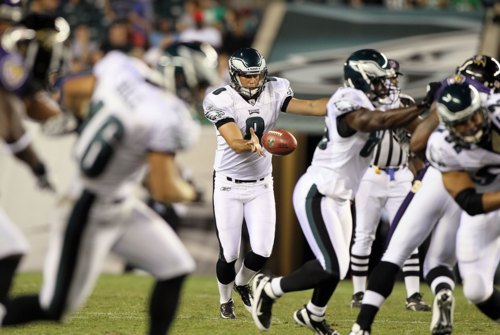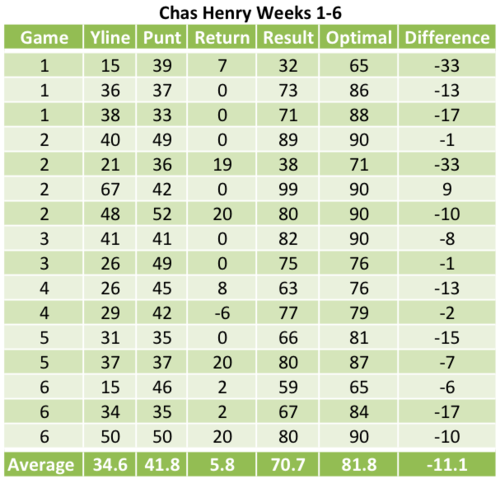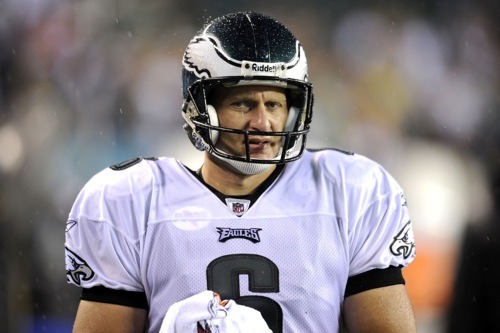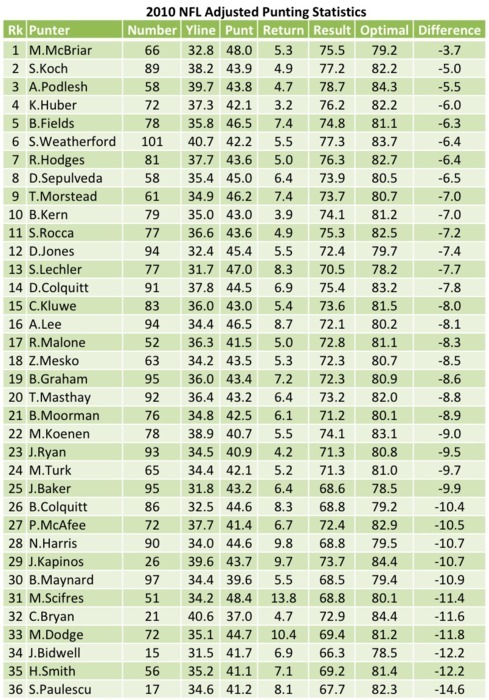Because someone has to read all the news coming out of the Eagles training camp.
* * *
When double-negatives attack. Bobby April told the press, in as roundabout a way as he could manage, that DeSean Jackson won’t be the primary punt returner anymore, now that he has his big contract:
“I don’t think that we’re not going to use him,” April said. “I just don’t know if he’s going to be the primary guy. … He’ll continue to work at the positiion. He just won’t get as much work as he normally does.”
* * *
Can’t lower the bar enough. April also said that while he was looking to bring in competition for Chas Henry, the former Florida punter did well for a rookie. That is simply not true. Among his fellow rookies, Henry had the second-lowest net average and tied for the lowest ratio of punts inside the 20 yard line to touchbacks, a rough measure of placement and touch. Needless to say, those stats look even worse compared to veterans.
UPDATE: Eagles signed former Cowboy Mat McBriar.
* * *
My kingdom for a Washburn post-game press conference. Jim Washburn is so candid. He talked to the press yesterday, and the quotes were flying. On Mike Patterson coming back from brain surgery:
“Mike Patterson might be one of the best people I’ve ever had,” said Washburn. “He doesn’t have to come to these rookie meetings at night and in the afternoon, he doesn’t have to be there, but guess what? He’s there. I said, ‘Mike, you don’t have to be here,’ and he said, ‘I like to be here.’ He likes football. He’s a good one. God dang, we miss him now.”
On Antonio Dixon:
“I was so disappointed,” said Washburn. “I couldn’t tell if he had any talent… I couldn’t tell if the guy was a good player or not. I couldn’t tell if he was a good athlete. He weighed 365 or something like that. His back was killing him. He was out of shape. I couldn’t even tell if he was a player. This spring, he worked his butt off. He’s down, I don’t know how much he weighs, he’s maybe 330 from 360 or whatever it was. He’s in so much better shape and I went, ‘Wow, this guy’s got some quickness.’ He likes to play and he’s tough, but he’s got ability.”
“He told me when I first got here, ‘I ain’t rotating,’” Washburn said Tuesday at Eagles training camp. “Said it right up there in that meeting room. I said, ‘Yes, you are … or your ass ain’t going to play.’ He’s a great kid, Trent.”
“He changed some of the habits in his life, I think,” Washburn said. “He got serious. … I don’t know, [he’s] a mild-mannered guy. He was a good player in college, he was. I watched every game he played in college for a year or two. He was a good player. Should be a good player here. Lost his weight. Got too heavy.” Graham, of course, is coming back from knee surgery after losing most of 2011.
* * *
Tearjerker. If you’re not rooting for lifelong Eagles fan Vinny Curry before, you will Be after you read Jeff McLane’s article about him. Plus, bonus Washburn quotes!
* * *
Mini-Asante? Multiple reports talked about UDFA Cliff Harris picking off a few passes during yesterday’s practices, putting him out to an early lead in the Training Camp Darling category. But let’s not go crazy here. There are no good wide receivers at camp, and some of the picks just demonstrate how bad Trent Edwards is.
* * *
On the other hand, I’m starting to let the continued positive reports on Mychal Kendricks get to me. He seems much more prepared than Casey Matthews was, at any rate.
* * *
Poorly Written Articles Edition. Bill Barnwell gives us what he pretends to be a statistical analysis of the top running backs in the game, but somehow concludes that Ray Rice is better than LeSean McCoy without demonstrating any number that backs that up.
Even less insightful was the book excerpt in Fast Company about how Jeff Lurie turned around the Eagles. What a waste of time.




